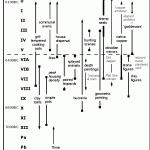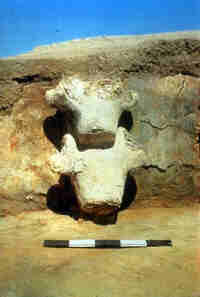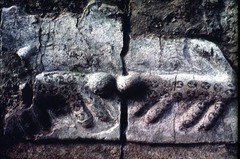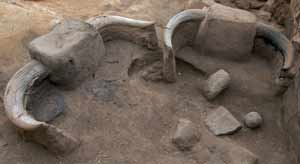Discussing whether the abundance of strange wildlife memorabilia in a place like Çatalhöyük happens when settled people kill all the local big game and become gradually disconnected from their hunting roots.

In a nearby country town there is an old hotel. On its wood-panelled walls are images of red coated ‘gentlemen’ on horses, and their hounds, all giving chase to some unseen fox. What’s missing in this hotel, but perhaps lives on in English country houses, is the other part of this display, the heads of wild animals or the unfortunate fur rugs.
Such fly-blown relics of another time are considered much less desirable to most people in Britain now. Fox hunting is currently illegal, but even before the ban it was already much less widespread than a hundred years ago. Taste’s change, I guess. But why did the pubs and the country houses have such paraphernalia at all? And what’s it got to do with Çatalhöyük?
‘Art’ at Çatalhöyük

The chronology of art and other features at Çatalhöyük, based on Mellaart and current work from the Çatalhöyük Research Project (click to enlarge)
When James Mellaart started to excavate the early Neolithic settlement mound of ‘Çatal Hüyük’, southern Anatolia, in the 1960s he revealed unusual figurative artwork in certain buildings among the mass of poky houses. This artwork didn’t appear to match anything seen in contemporary societies of the Fertile Crescent, further east.
The following list is not exhaustive but gives an idea of some of this ‘art’ and at what period different types of figurative artwork seemed to occur in the houses. I shall attempt to make the list chronological (it should be mentioned that level V contains little evidence of any artwork)
Bull bucrania and horn cores
Bull bucrania are the tops of wild bulls’ skulls, including the horns. Bucrania and horn cores were generally found buried in plaster ‘bulls’ heads’ in walls, or were set in rows on benches in the northern halves of some houses. The bulls’ heads were often decorated.
Much rarer were rams’ horns or bucrania and rams’ heads.  Other animal bones included the jaws of wild boar and other smaller wild animals, embedded in plaster ‘breasts’ within the walls.
Other animal bones included the jaws of wild boar and other smaller wild animals, embedded in plaster ‘breasts’ within the walls.
Apart from in some cases in level VIA and B most of the bull bucrania and horn cores appear to have been removed before demolition of the buildings. Bucrania date from CH level IX to at least level II (about 6850 – 6200 BC), becoming rarer after level VIA (around 6400BC). Animal heads disappear altogether after level VIA.
Paired Leopard Reliefs
These painted plaster wall reliefs show side profiles of two animals, probably leopards, touching noses as if mirrored. They appear between levels VIII and the end of level VI (about 6650-6400BC). They are rare, being confined to the ‘leopard house’. However, here these reliefs were maintained and refurbished repeatedly.
 As Ian Hodder has pointed out, the lack of leopard bone on the site suggests that whole dead leopards may not have been brought into the settlement, which he believes is due to some taboo. Whatever, the pairing of the animals suggests a cult element to the reliefs.
As Ian Hodder has pointed out, the lack of leopard bone on the site suggests that whole dead leopards may not have been brought into the settlement, which he believes is due to some taboo. Whatever, the pairing of the animals suggests a cult element to the reliefs.
‘Death’ paintings
There are various paintings recorded by Mellaart from levels VIII to IV (about 6650-6300BC), showing headless people and ‘vultures’ or people dressed up as vultures, as well as a couple of paintings possibly showing a mortuary house and dead people’s heads. They appear to relate to a period of burial decapitation and skull preservation and are presumably cult-related.
‘Mother Goddess’ or ‘bear’ reliefs
 These wall reliefs, again in painted plaster, are unusual in showing a possibly splayed figure with limbs sticking out at right angles, upturned at the ends. They date from levels VII to the end of VI (about 6600-6400BC).
These wall reliefs, again in painted plaster, are unusual in showing a possibly splayed figure with limbs sticking out at right angles, upturned at the ends. They date from levels VII to the end of VI (about 6600-6400BC).
James Mellaart, on the basis of an apparent swollen ‘bellybutton’ on one and the presence of plaster bulls’ heads beneath some of them, thought that they were women or ‘goddesses’, giving birth to animals. This suggests a very cult purpose. However, Ian Hodder found evidence for a matching form on a later stamp seal that strongly suggests these are animal reliefs, probably of bears.
 Perhaps most interestingly, the heads and ‘paws’ of these plaster reliefs were always broken off when a house was demolished and built over. While this may again suggest a ritual or cult purpose, it seems just as likely to me that the reliefs were plaster ‘fake bear-skin’ wall hangings (?possibly with the insides facing inward). If this is true it may be that real skulls and paws were embedded in the plaster and that these were removed when houses were demolished, as was the case with many bull bucrania and horn cores. I’ll come back to this point.
Perhaps most interestingly, the heads and ‘paws’ of these plaster reliefs were always broken off when a house was demolished and built over. While this may again suggest a ritual or cult purpose, it seems just as likely to me that the reliefs were plaster ‘fake bear-skin’ wall hangings (?possibly with the insides facing inward). If this is true it may be that real skulls and paws were embedded in the plaster and that these were removed when houses were demolished, as was the case with many bull bucrania and horn cores. I’ll come back to this point.
Sunk relief animals
Little known, these animal pictures, the best of which appear to be bulls, were recorded by Mellaart on walls upto level VI A (6400BC). They were made by stripping off multiple layers of plaster in the shapes of animals then replastering and painting the resulting depressions.
The ‘volcano and town’ or ‘leopard-skin’ painting
 This is a one off in CH, dated to level VII (about 6500BC). As James Mellaart pointed out, the painting appears to show a volcano exploding over a town. The nearest volcano is Hasan Dağ, which would have been visible in the distance and was probably active at the time, so the image could be a contemporary representation of CH.
This is a one off in CH, dated to level VII (about 6500BC). As James Mellaart pointed out, the painting appears to show a volcano exploding over a town. The nearest volcano is Hasan Dağ, which would have been visible in the distance and was probably active at the time, so the image could be a contemporary representation of CH.
However, a more recent interpretation is that the ‘volcano’ is in fact a headless and pawless (and hence boneless) animal skin, perhaps of a leopard, and that the rest of the image is abstract (like many other paintings across walls in the site). This would be interesting as the lack of leopard bones on the site does not preclude the presence of bone-free leopard skins.
Hunting scenes
 These are later than the above features, occurring between levels V and III (perhaps 6400-6250BC) and seem to represent quite a change in art style. The pictures show scenes of animal ‘hunts’ where a wild animal, perhaps wild bull, deer or boar, is surrounded by people.
These are later than the above features, occurring between levels V and III (perhaps 6400-6250BC) and seem to represent quite a change in art style. The pictures show scenes of animal ‘hunts’ where a wild animal, perhaps wild bull, deer or boar, is surrounded by people.
The animals are large, dwarfing the people, are male and appear to be simultaneously sexually aroused and dead. The people, almost all men, are drawn like stick men. They carry weapons and are shown rushing around and looking somewhat overheated. They often, but not always, wear ‘leopard skin’ around their waists.
After level III there’s no more hunting or wild animal related art, unless that is you count the famous statue of a ‘Mother Goddess’ resting between two leopards from a grain silo in level II (around 6200BC). In fact ‘Mother Goddess’ art now predominates, as it does further East.
Statuettes
Cult statuettes, both of animals and people, made out of both clay and stone, appear throughout the later CH sequence from level VII onward. Many stone figurines, including ‘mother goddesses’, date to level VIA, but this is probably a reflection of their loss in the fire that happened at this time, and it may be that they existed earlier but were not normally buried or thrown away. The classic clay figurines of ‘mother goddesses’ with leopards occur later in the sequence, in levels III and II.
Discussion
‘Hunting memorabilia’
It would be wrong to call the wild animal and hunting-related materials above simple ‘hunting memorabilia’. People’s reasons for putting trophies on their walls now are generally egotistical and have no religious aspect. I don’t think that the people of CH would understand this idea. Their world was probably full of significance. If they put the skin of an animal on a wall it would have meant something deeper.
It would also be wrong to see the later hunting paintings, as with all the paintings, as simply nice decorations. They appear only on certain layers of plaster and are often obliterated by later plasterings. Some may have been shown for much less than a year.
A possible sequence of events
 It seems to me that the succession of events here could be telling a story of some sort (one that’s probably not a million miles from Ian Hodder’s). CH is unusual for this period in showing little evidence of domesticated cattle until very late. Other sites further east show evidence of cattle domestication as far back as the early eighth millennium BC, well over a thousand years before what’s described here.
It seems to me that the succession of events here could be telling a story of some sort (one that’s probably not a million miles from Ian Hodder’s). CH is unusual for this period in showing little evidence of domesticated cattle until very late. Other sites further east show evidence of cattle domestication as far back as the early eighth millennium BC, well over a thousand years before what’s described here.
A simple suggestion, which has been made before, is that the people of CH were descended from people indigenous to the area, not from farmers further East. Maybe they were local hunters who had turned to a settled life for other reasons (perhaps trade, perhaps obsidian though maybe not). This would certainly help to explain the preponderance of ‘hunting memorabilia’.
These settled hunters took on many of the trappings of agriculture, such as growing wheat and barley and herding sheep and goats. Limited evidence suggests that CH did have immigrants into its population (as suggested by recent dental studies) and some of these, perhaps from the East, could well have contributed to this hunting-farming balance. However, the dominant culture was, apparently, one celebrating the joys of the hunt. There is nothing like it seen in contemporary Eastern Turkey or Syria.
It seems to me that many of the paintings and reliefs discussed above could show how the population of CH went from being hunters to just pretending they were hunters. There’s no doubt that most of the bull bucrania came from wild animals. These can easily be seen as trophies of the hunt. But I suspect that they came to be increasingly valued and significant as the animals became rarer in the countryside round about.
If the idea of bear skin wall hangings is right then this shows such an effect well. I’d suggest that initially real bear skins might have been hung on walls as significant ‘trophies’. However in the damp conditions of the houses these skins decayed with time. Eventually, people, unable to replace them, started faking bear skins on their walls with plaster and paint, using the surviving bones to give the fake skins some sense of deeper meaning, connected with the original wild animals that they came from.
After the fire – hunting in story
A great fire or series of fires appear to have swept through the settlement around the end of level VIA (around 6400BC). This may have damaged or destroyed much of the hunting memorabilia in the settlement as the evidence for very high temperatures shows. After this time there are no recreated ‘bear skins’, plaster leopards or animal carvings and few bucrania.
For perhaps a hundred years after this people painted hunting scenes on the walls and I’d guess that by this time these were fabulous illustrations for stories told of a past age, the ‘time of the great hunts’, with mythical heroes at their centres, when animals were mighty and everyone pranced around in luxurious leopard skin. Meanwhile the reality may have been that the first domesticated cattle were being imported from far to the East. Life, in fact, was turning much more domestic.
By 6200 BC even the pictures stopped. Perhaps the people of CH had forgotten their ancestors had ever been great hunters at all.
References
Edwards, C. J. et al. 2010, A Complete Mitochondrial Genome Sequence from a Mesolithic Wild Aurochs (Bos primigenius), PLoS ONE 5(2).
Hodder, I. 2006 Çatalhöyük: The Leopard’s Tale: Revealing the Mysteries of Turkey’s Ancient ‘Town’, pp288.
Hodder, I. & Meskell, L. 2010 The symbolism of Çatalhöyük in its regional context, In: Hodder, I. (ed) “Religion in the Emergence of Civilization: Çatalhöyük as a Case Study”, Cambridge p33-72.
Hongo, H. et al. 2009 The Process of Ungulate Domestication at Çayönü, Southeastern Turkey: A Multidisciplinary Approach focusing on Bos sp. and Cervus elaphus, Anthropozoologica 44, p63-78.
Mellaart, J. 1967, Catal Huyuk: A Neolithic Town in Anatolia, McGraw- Hill (New Aspects of Archaeology, pp232.
Pilloud, M. A. 2009 Community Structure at Neolithic Çatalhöyük: Biological Distance Analysis of Household, Neighborhood, and Settlement, Ohio University PhD Thesis, pp774.
Pilloud, M. A. & Larsen, C. S. 2011 “Official” and “practical” kin: Inferring social and community structure from dental phenotype at Neolithic Çatalhöyük, Turkey, American Journal of Physical Anthropology 145, p519-530.
(these two works refer to the dental evidence for relatedness or lack of it in domestic burials)
Sagona, A. & Zimansky, P.E. 2009 Ancient Turkey, Routeledge, pp408.
Türkan, A. U. 2007 Is it goddess or bear? The role of Çatalhöyük animal seals in Neolithic symbolism, Documenta Praehistorica 34, p257-266.
Çatalhöyük Research Project website
¹º²³

{ 2 comments… read them below or add one }
Hi Ned,
An interesting piece, a fascinating puzzle which illustrates the limits of archaeological interpretation. Trying to understand art and craft in isolation, without any real cultural reference points, is a dangerous game. What is documentary, symbolic, or mythic is always going to be a movable feast.
I think Egyptian, [or even Christian] art, illustrates, that without the cultural frames of reference that literature provides, any analysis probable tells more about the nature of contemporary scholarship, than the motivations and perceptions of the original craftsmen.
Or I am I being a little harsh?
Dear Geoff
I suspect that archaeologists, and the post, deserve a little harshness if they put too many frills on their (my) interpretations. I guess it comes down to the interpreter rearranging his/her scanty jigsaw pieces, then desperately filling in the spaces to come up with a picture that makes them feel happy (ideally until some further data comes to light which means the pieces have to be rearranged again to get a sensible picture). None of this appears be like science as it’s mostly untestable (actually, much like my old subject, geology). I can bend my ideas through 90 degrees and nothing seems to break. The lack of writing or any idea of ancient peoples’ thoughts is a profound loss to archaeology, making arguable interpretations range from the worldly to the strange to the alien. I think the fascinating example of how people’s attitudes to the Maya changed (from peaceable to scary) when their glyphic texts were first read should be a lesson to us all. Is it part of mainstream archaeology teaching? It should be.
love Ned